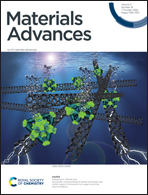Sea-urchin-like iron-cobalt phosphide as an advanced anode material for lithium ion batteries†
Abstract
Lithium-ion batteries (LIBs) are the most advanced and well-developed renewable energy storage solutions over the last three decades. Resourceful and cost-effective transition metal phosphides (TMPs) have gained immense attention for various energy storage devices due to their excellent electrochemical properties. Here, we report a bimetallic phosphide (iron-cobalt phosphide, FeCoP) synthesized by a simple hydrothermal method followed by a low-temperature phosphorization. We have used this material as the anode for LIBs with lithium foil as the counter and reference and 1 M lithium hexafluorophosphate (LiPF6) in a mixture of EC : DMC (1 : 1) as the electrolyte. The electrochemical tests reveal that the device exhibited an excellent discharge capacity of 1653.4 mA h g−1 at a current density of 100 mA g−1. The device retained about 80% of its performance even after 1000 cycles at a current density of 5 A g−1. The performance of the synthesized material shows that TMPs are of great use for the application of LIBs.



 Please wait while we load your content...
Please wait while we load your content...